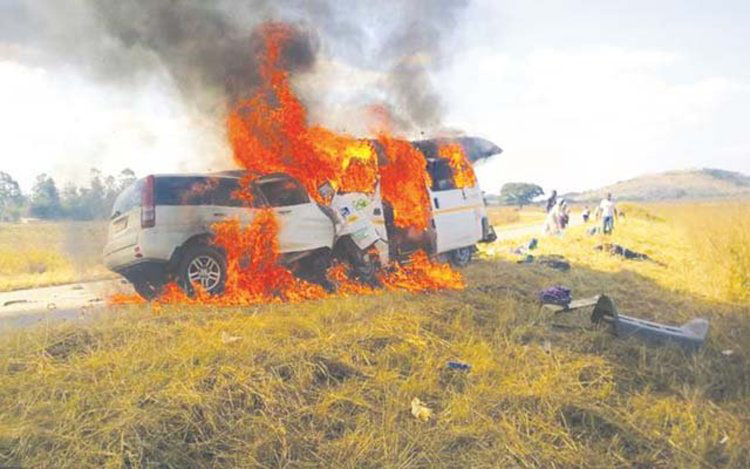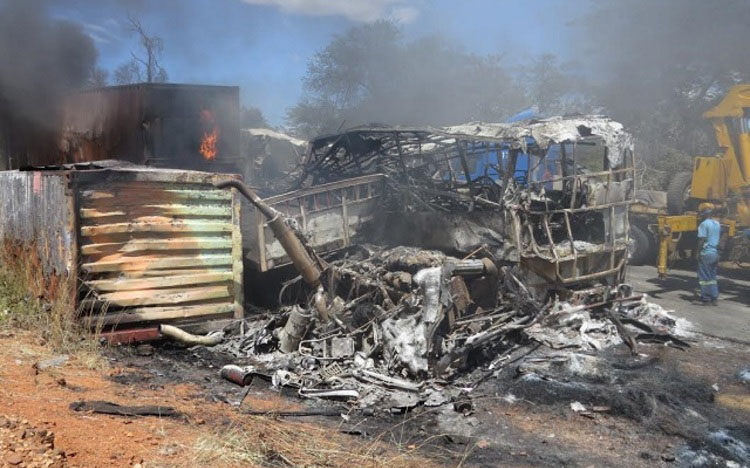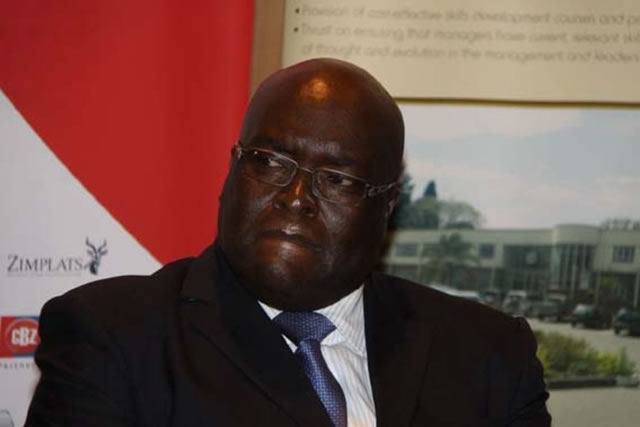Zim’s emergency care found wanting


11 people were killed and burnt beyond recognition while 14 others were injured at the 60 kilometre peg along the Mvurwi-Centenary Road on Monday
Nicholas Chidowore Correspondent
On Monday, 11 people were killed and burnt beyond recognition while 14 others were injured when a Honda CRV collided head-on with a Nissan Caravan at the 60 kilometre peg along the Mvurwi-Centenary Road.
Both police and ambulance services’ response was very slow, considering that they were coming from Mvurwi District Hospital, which is less than 15 kilometres from the accident scene.
Since Mvurwi Hospital only has one ambulance , they had to mobilise three other ambulances from other hospitals to assist ferrying the injured to the hospital because of the magnitude of the problem.
In June this year, the country also suffered two of the most horrific bus accidents; one involving Proliner Bus company where 30 passengers travelling to South Africa died after their bus collided with a haulage truck at Nyamatikiti River along Masvingo Road, the other involved the King Lion bus awhich killed 43 people on the HArare-Chirundu highway.
The accidents mentioned prove how Zimbabwe is losing critical human capital due to unnecessary loss of life in Road Traffic accidents (RTAs). Those who survive are left with disabilities and rendered incapable of taking care of their families and fail to provide essential services to the nation.
All these major accidents are occurring in our national highways and surviving victims are usually referred to the closest local clinics and district hospitals which are not well equipped to deal with major traumatised victims.
This forces the ill prepared provincial and district hospital to refer victims of these accidents to the referral hospitals sometimes without adequate resuscitation or stabilisation.
In addition, there is lack of basic pre-hospital emergency care, which was evidenced by the most recent disaster in Mvurwi where there were critical shortages of ambulances and victims had to be ferried using public transport.
This leaves victims of road traffic accidents exposed to several error prone environments and if error occurs it translates into considerable morbidity and mortality.
According to a study done by Reynolds et al, 2014 most low-income countries like Zimbabwe lack organised emergency care systems and therefore continue to suffer the highest rates of injury, from RTAs worsening the already existing primary health burdens such as, maternal death due to complications of pregnancy, and acute medical complications of communicable diseases involving TB, malaria and HIV. Unfortunately, Zimbabwe is not spared from this statement.
Zimbabwe like most countries in Africa, nurses are seen as the backbone to health service delivery and are often the first (and sometimes the only) health professional available to manage a severely injured client.
However, many of the nurses in the provincial and district hospitals are often or completely under prepared for the complex management and/or stabilisation of such clients.
To date, no standards operating guidelines exist to guide the nurses and doctors working in emergency areas in Zimbabwe and this has led to unnecessary loss of lives. Over the years, emergency care issues have been raised but nothing has been done at policy level to improve our emergency care.
Shortage of doctors often leads to task shifting to nurses who are called upon to initiate emergency care and help stabilise the client with limited guidelines or standards before the medical practitioner who also lacks training arrives continue to be unprepared and lack basic skills.
Impact of road traffic accidents in Zimbabwe
RTAs have an estimated 70 percent mortality due to lack of proper pre-hospital emergency care, and almost 30 percent of those being transported from the accident scene die before reaching a place of definitive care.
Those who reach health care centres should survive yet sometimes do not get proper treatment. According to the Passenger Association of Zimbabwe, most institutions have an acute shortage of well trained staff in trauma and emergency care with the emergency equipment out-dated and in most cases defunct.
The World Health Organisation (WHO) estimates that about 1,24 million people are killed in road traffic accidents each year and another 50 million are injured or disabled permanently.
In Africa, an estimated 157 875 people aged 15 and over were killed in road traffic accidents the majority of them in the 15-59-year age group. A study by Bergman et al 2008 revealed that in sub-Saharan Africa, injury is responsible for more deaths and disability-adjusted life years than AIDS and malaria combined.

Some of the accidents include a Proliner Bus where 30 passengers died at Nyamatikiti River along Masvingo Road with the other one involving a King Lion bus that claimed 43 lives along the Harare-Chirundu highway
Unfortunately for our country the road traffic accidents statistics only look at those who died on the spot without addressing the issue of how many could have been saved if the country had an efficient pre-hospital emergency care in place.
A study carried out by Gosselin, et al, 2009, showed that more than 90 percent of injury related deaths that occur in low and middle income countries, where traumatic injuries and their related issues and this was a significant contributor to the on-going cycle of poverty, with related socioeconomic impact on individuals, communities and societies.
The Solution
While acute care systems can substantially lower the morbidity and mortality associated with a wide range of medical and surgical conditions in adults and children, few healthcare facilities in the region adopt an integrated approach to resuscitation and stabilisation. (Calvello et al 2013).
Emergency care in low income countries like Zimbabwe has been under-emphasised, due to policies focusing on communicable diseases and maternal child health. However, with training, effective and efficient emergency care is possible.
Comprehensive emergency care occurs on a continuum which begins with pre-hospital care which refers to the acute and emergency care delivered outside the walls of a fixed healthcare facility. All the steps leading up to, and following, pre-hospital care becomes critical to minimise a victim’s likelihood of death or disability.
This “chain of survival” includes recognition of the emergency, bystander-initiated care, access to pre-hospital emergency care services, pre-hospital care delivery, emergency transportation, emergency centre care and definitive care.
Development of pre-hospital trauma care systems should thus be an integral component of the emergency care system in Zimbabwe. The current lack of a comprehensive nationalised emergency care system especially for those that need urgent care and are outside the 40km radius which urban ambulances don’t reach is an urgent matter which needs to be addressed
In order to save lives and avoid the unnecessary maiming of accident victims, Government clinics and hospitals should be equipped with the necessary provisions for initial resuscitation, stabilisation, and treatment to acutely ill and injured patients, and delivery of those patients to the best available definitive care, regardless of their ability to pay.
A comprehensive emergency care system should also include:
1. Acute care referral systems (pre-facility, transfer, and field care)
2. Facility — based acute care,
3. Emergency medicine specialist training,
4. Emergency nursing,
5. Sustainability strategies (advocacy, policy, and funding).
There is an undisputed need for revamp of the emergency care systems in Zimbabwe to help relieve toll of RTAs on human life. However, poor health financing, lack of resources and personnel continue to be the major deterrent towards achieving change.
The World Health Organisation has been advocating for the strengthening of integrated formal trauma care systems in low-resource settings to alleviate the burden of disease from RTAs injuries, but Zimbabwe has not taken any formal steps to train or set up of formalised emergency care.
Zimbabwe has a strong foundation of medical care and education, but currently doesn’t offer any specialty training in emergency medicine or nursing.
With an estimated increase of RTAs due to increase in access to motor vehicles and poor roads infrastructure, and a lack of a comprehensive emergency care system there will be an unnecessary continued loss of critical human capital in the country.
There is evidence that educational initiatives improve knowledge and clinical confidence among health-workers, it is high time Zimbabwe took the bull by the horns and started implementing training programmes.
The lack of tangible data and accurate estimates of mortality and morbidity rates in the country is also a major challenge for implementing policy-making and public-health initiatives in this area.
Research and proper documentation on the impact of RTAs on the economy and human development needs to be done to guide policy development and implementation in the country.
Conclusion
The World Health Organisation and the International Association for Trauma Surgery and Intensive Care have published the “Guidelines for Essential Trauma Care.” This provides recommendations for the human and physical resources needed to provide an adequate, essential level of trauma care services in countries at all economic levels worldwide.
At present trends, with no effective mitigation, it is projected that globally by 2030, road traffic injuries will rank as the 5th leading cause of death after cancer, cardiovascular disease, COPD (chronic obstructive pulmonary disease), and acute respiratory infections (WHO 2009).
There should be efforts by the Government and the private sector to introduce and standardise various emergency training programmes to ensure that health professionals in Zimbabwe have the necessary skills to manage emergency clients.
The burden of injury in Zimbabwe represents a significant public health threat, and underscores the need for skilled health care workers.
While recent studies have called for increasing attention to emergency and trauma care, the health sector in Zimbabwe currently lacks training in these areas, resulting in delays in appropriate and timely emergency care, and associated poor clinical outcomes.










Comments